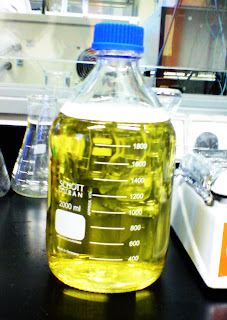=D
Objectives
1. To describe the steps to prepare a bioreactor
2. To prepare the media for seed culture and scale-up fermentation
3. To prepare seed culture for scale-up fermentation
Preparation of Media
- 2.0L of Luria – Bertani(LB) Medium was prepared.
- 100ml of the medium was transferred to a shaker flask and the remaining 1900ml was transferred into the 2L bioreactor.
- The medium was autoclaved at 121oC for 20 minutes and allowed to be cooled.
- Once the broth has cooled to below 50 oC, ampicillin was added to a final concentration of 100ug/ml to both the bioreactor and the shaker flask.
- The media was kept at 4 oC till inoculation.
Preparation of Bioreactor
- The pH electrode was calibrated with the standard buffer solution
- The pH probe, pO2 probe, foam and level probe was install into the top plate. (level was checked)
- The addition agent lines for acid, base and antifoam was connected. (level was checked)
- Other accessories such as exhaust condensers, air inlet and exhaust filters and manual sampler unit was installed. (water jacket was checked)
- Sterilization: All cables except the temperature probe were disconnected. All silicone tubings except for exhaust filter and female STT coupling of sampling unit was clamped.
- All filters and sockets were covered with aluminum foil. The setup was autoclaved with steam at 121 oC for 20 minutes.
- pO2 electrode was polarized for 6 hours and calibrated by aerating with nitrogen.
- Additional lines were connected to peristaltic pumps and bioreactor was switch to “auto”/”manual”.
Preparation of Seed Culture
- pGLO transformed Escherichia. Coli was retrieved from -80 oC freezer.
- The E.coli was streaked onto a LB/AMP/Ara plate ( ampicillin 100ug/ml and arabinose 0.2%) and incubated for 24 hours.
- Several colonies of pGLO transformed E.coli was obtained and transfer to the shaker flask
- The shaker flask was placed in a shaking incubator and incubated at 32 oC for 24 hours.
- This was then used to inoculate the fermentor for scale-up fermentation.


Mr Ong is explainning to us. See how attentive we are!!!! (we just love MR ONG!!!right ida?)photos taken by edyna
Further Questions:
1. On media preparation:
a. Explain the purpose of each ingredient found in the LB media.
Bacto-tryptone: This ingredient provides the necessary peptides and peptones required by the bacterial cells.
Yeast extract: This ingredient provides vitamins and various trace elements required by the bacterial cells
NaCl: This ingredient provides essential ions and contributes to the osmotic stability of the bacterial cells
dH2O: This ingredient is used as a solvent
b. What is the purpose of ampicillin?
The purpose of ampicillin is to prevent the growth of other unwanted microorganisms.
c. Why is ampicillin added only after autoclaving?
Autoclaving will destroy all the microorganisms present in the LB media. Ampicillin is added later to ensure that other microorganisms do not contaminate the medium after autoclaving.
2. On equipment preparation:
a. What is meant by calibration of the pH probe?
Calibration of the pH probe means to correlate the voltage produced by the probe with the pH scale.
b. Why is hydrochloric acid not suitable as a correction agent for pH?
HCL is not suitable as a correction of the pH probe because it is one of the most corrosive acid and it corrodes the metals in the fermenter. Morover,contact between HCL and metals produce hydrogen gas and this creates the chance of an explosion.
c. What is meant by polarization of the pO2 probe?
pO2 probes consist of 2 electrodes, the anode and the cathode, which are both immersed in electrolyte within the sensor body. An oxygen permeable membrane separates the anode and cathode from the water/solution being measured. Oxygen in the solution can diffuse through the membrane. The cathode is the point whereby the oxygen is reduced, and 4 electrons or current is generated directly proportional to the oxygen consumed at the cathode. The electric current generated to measure the amount of saturated oxygen in the solution. However, the reduction of oxygen at the cathode can only happen when the probe is polarized at around 800 mV. Polarization at 800 mV means the difference between the negative cell and positive cell is 800 mV.
d. What is a peristaltic pump?
A peristaltic pump is a type of positive displacement pump used for pumping a variety of fluids.Peristaltic pumps are used to pump clean or sterile fluids because the pump cannot contaminate the fluid and to pump aggressive fluids because the fluid cannot contaminate the pump.
3. On seed preparation:
a. What is the purpose of arabinose?
The purpose of Arabinose is to induce the production of the Green Fluorescent Protein.
b. Describe the sterile techniques used in seed preparation.
The seed preparation was done in a laminar fume hood, the inoculating loop used to inoculate the bacteria was sterilized over a Bunsen flame and the spreader used to spread the bacteria was soaked in ethanol and sterilized by fire before being used to spread the bacteria culture.
c. Why do we perform step-wise scale-up instead of transferring directly to the fermenter?
Cell culture is scaled up step-wise so as to allow the cells to adapt to the culture conditions .
0 Comments:





Post a Comment
<< Home